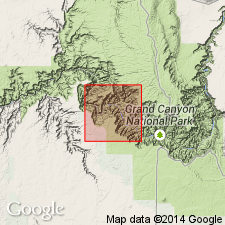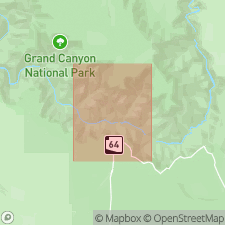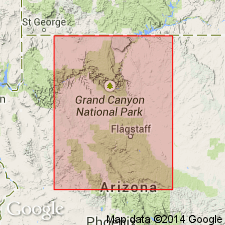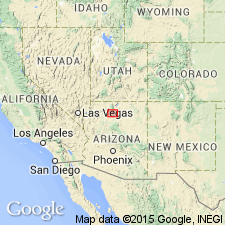
- Usage in publication:
-
- Hakatai shale*
- Modifications:
-
- Original reference
- Dominant lithology:
-
- Shale
- Slate
- Sandstone
- AAPG geologic province:
-
- Southern Rocky Mountain region
Summary:
Hakatai shale of Unkar group of Grand Canyon series. Red argillaceous shale grading upward into arenaceous red shale and sandstone. Nearly all beds contain sun cracks and ripple marks. Thickness 580 feet. Cut by a thick sill of intrusive diabase, which has converted the shale into slate and jasper near the contact. Conformably overlain by Shinumo quartzite and conformably underlain by Bass limestone, all of which belong to Unkar group. Age is pre-Cambrian (Grand Canyon). Report includes geologic map.
Named from Hakatai Canyon, north side of Colorado River, Grand Canyon, Shinumo quadrangle, Coconino Co., northern AZ, where typically exposed.
Source: US geologic names lexicon (USGS Bull. 896, p. 896); supplemental information from GNU records (USGS DDS-6; Denver GNULEX).

- Usage in publication:
-
- Hakatai shale
- Modifications:
-
- Areal extent
- AAPG geologic province:
-
- Southern Rocky Mountain region
Summary:
Hakatai shale. Thickness 600 feet in Bright Angel quadrangle, northern Arizona. Includes diabase sills. Overlies Bass limestone; underlies Shinumo quartzite. Age is Precambrian (Grand Canyon).
Source: US geologic names lexicon (USGS Bull. 1200, p. 1646).

- Usage in publication:
-
- Hakatai Shale*
- Modifications:
-
- Overview
- AAPG geologic province:
-
- Southern Rocky Mountain region
Summary:
Is the second of five formations of the Unkar Group and of the Grand Canyon Supergroup of Early Proterozoic age. Lower member is a purple to reddish-purple mudstone interbedded with sandy siltstone and rarely thin sandstone beds. Lower contact of member with underlying Bass Limestone placed arbitrarily at the top of the highest laterally continuous sandstone. Upper contact with middle member placed arbitrarily at change from purple to red-orange. Middle member is the most distinct redbed in the Grand Canyon being composed of red-orange mudstone, siltstone, and subordinate sandy siltstone. Small to large (up to 10 cm across) non-red, spherical to spheroidal reduction spots common in middle member. Large difference between paleomagnetic poles for the lower and upper members suggest accumulation and alteration of middle member occurred over a span perhaps of more than 10 m.y. Upper member consists of purple or lavender, fine- to coarse-grained, cross-bedded, ledge- and cliff-forming sandstone. Hakatai is 125 m thick. Is unconformably overlain by Shinumo Quartzite of Unkar Group. Geologic map; stratigraphic figure and table.
Source: GNU records (USGS DDS-6; Denver GNULEX).

- Usage in publication:
-
- Hakatai Shale*
- Modifications:
-
- Age modified
- AAPG geologic province:
-
- Southern Rocky Mountain region
Summary:
Is a formation in the Unkar Group of the Grand Canyon Supergroup. Overlies Bass Limestone of Unkar and unconformably underlies Shinumo Quartzite of Unkar. Ranges from 131-253 m thick. Designation of age of Precambrian Y changed to Middle Proterozoic, the age term used for rocks older than 900 Ma and younger than 1,600 Ma. The lower member accumulated under quiet conditions during the waning phases of marine deposition. The middle member accumulated in a subaerial environment. The upper member is probably of marine deltaic origin. Used in the Southern Rocky Mountain region of northern AZ. Columnar section.
Source: GNU records (USGS DDS-6; Denver GNULEX).
For more information, please contact Nancy Stamm, Geologic Names Committee Secretary.
Asterisk (*) indicates published by U.S. Geological Survey authors.
"No current usage" (†) implies that a name has been abandoned or has fallen into disuse. Former usage and, if known, replacement name given in parentheses ( ).
Slash (/) indicates name conflicts with nomenclatural guidelines (CSN, 1933; ACSN, 1961, 1970; NACSN, 1983, 2005, 2021). May be explained within brackets ([ ]).

